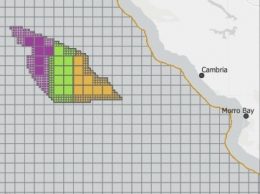Cal Poly study: Morro Bay wind power could bring thousands of jobs
IN THIS ARTICLE
- Central Coast Topic
- Tony Biasotti Author
By Tony Biasotti Friday, June 4th, 2021
A wind farm off the coast of Morro Bay could bring 650 jobs and $262 million in annual economic impact to the Central Coast, and an onshore port to assemble and service wind turbines would be a much bigger economic boost, according to a new study by researchers from Cal Poly San Luis Obispo.
The study was commissioned by the Regional Economic Action Coalition, or REACH, and conducted by a team from Cal Poly led by Economic Professor Stephen Hamilton. The study looked at potential wind farms between 3 and 7 gigawatts. That type of project appears likely in the Morro Bay area after the federal and state governments announced an agreement on May 25 to permit offshore wind turbines on 399 square miles offshore.
A 3 gigawatt project would generate 1,098 jobs statewide, with 617 of them in San Luis Obispo County and 33 in Santa Barbara County. The annual economic output would be $396 million statewide, including $254.5 million in San Luis Obispo County and $8 million in Santa Barbara County.
The biggest economic benefits of offshore wind would come not from the wind farm itself, but from an onshore port where turbines are assembled and serviced. If the port is not built on the Central Coast region and turbines are imported fully assembled from Asia, the economic impact to the region would be much smaller.
Construction of an onshore port would generate nearly 16,000 jobs and close to $3 billion in total spending over five years. Around 75% of the jobs and 67% of the economic output would be in San Luis Obispo County.
“We need to step up and explore what it would take to make sure those jobs land here in SLO County,” San Luis Obispo County Supervisor Dawn Ortiz-Legg said in a REACH news release. “We have a long history as an energy-producing county, and this offers the possibility of reinventing that legacy as a central underpinning of our economy.”
Though turbines can be assembled and serviced elsewhere, it’s ideal to do that work close to the wind farm, Walt Musial, offshore wind manager for the National Renewable Energy Laboratory, said in the REACH release.
“Proximity matters,” he said. “The port handling construction, maintenance and repairs needs to be relatively close to the call area to achieve low energy costs, reduce emissions and maximize the amount of time the turbines are on the water generating electricity.”
Related Articles
Central Coast economic development initiative scores $5M state grant
 Friday, October 14th, 2022
Friday, October 14th, 2022








